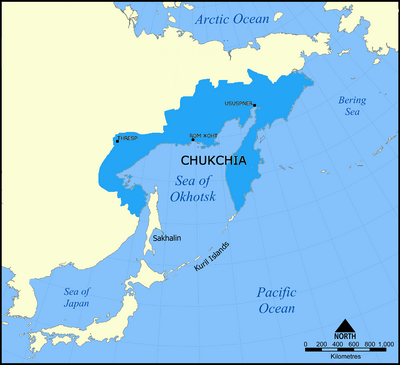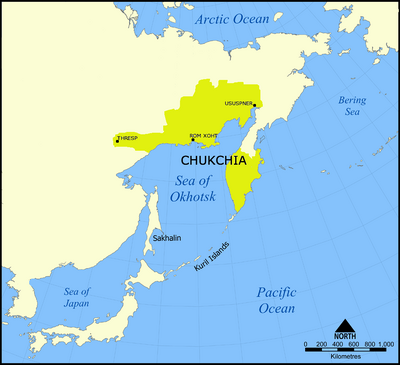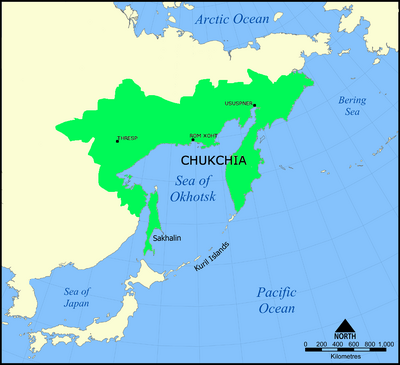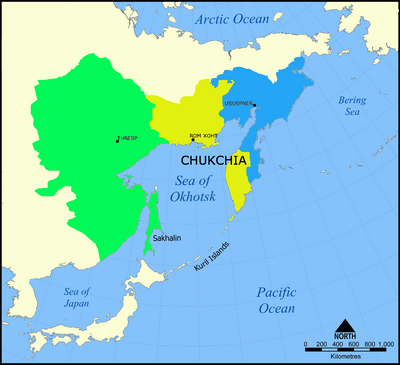
Flag of Chukchia
The Republic of Chukchia, commonly known as Chukchia, was formed in 1991 after the collapse of the Soviet Union.
History[]
Chukchee Civilization[]
Because of the high population, a civilization in the Chukchee homeland is developed as early as 250 A.D. A unified monarchy arose around the city-state of Rom Xoht (Great City in Chukchee), in 463 a.d.. This was the Xohtian dynasty. Another city named Ususpner (Garden) rebelled and created the Ususparian Dynasty, in 883 a.d.. This was the golden age of ancient Chukchia, and during this time contact with China was made. Thsrep (Sky Blue), which was the last of the three main Chukchee cities, created its own dynasty in 1204, the Thrasp Dynasty. However during its brief reign (it only lasted until 1217) the empire of the Chukchee, which had greatly expanded under the past two dynasties, declined and was very unstable. It is likely that it would have ended around the 1260 even if the Mongols hadn't invaded.

Map of Chukchia, Ususparian Dynasty

Map of the Xohtian Dynasty
Mongol and Thrasp Invasions[]
Genghis Khan started an invasion of the Thrasp dynasty and several months later it collapsed, in 1217. Chukchia was spared from devastation, partly because the Chukchees were one of the few people who followed the same religion as the Mongols (Tengrilism) and were very much similar to the mongols culturally and ethnically.

Map of the Thrasp Dynasty
Chukchees were also all-to-happy to see the Thrasp Dynasty go. In Chukchia, most educated Chukchees learned Mongolian. When in 1368, the Mongol Empire collapsed Chukchia was in a great civil war. The massive civil war went on until 1379, when a treaty was created that would divide Chukchia into three kingdoms, each controlled by one of the three powerful dynasties that had controls Chukchia before the Mongols. While the Neo-Thrasp dynasty was a violent government of Oligarchs, the Neo-Xohtian Dynasty and Neo-Ususparian Dynasty were very technologically advanced. Contact with the Chinese Ming dynasty was re-established in 1413, when old trade routes were reused. The Neo-Xhotian dynasty became the area's center of commerce. In the 1430s the Neo-Thrasp dynasty started very violent campaigns upon less civilized peoples. By 1450, most of eastern Siberia was under the Neo-Thrasp dynasty's iron grip. Contact with the Khanate of Kazan was made in 1462, and the following year (much to the people's distaste) The Neo-Thrasp Empire became a Muslim Kingdom. They then conquered the other two Chukchee nations in Islam's name.
Russian Conquest[]
Despite the might of the Sultanate of Thraspjuk ( as it was now called) portions of the other two kingdoms, where Tengrilism was still practiced, remained independent. They were living with the constant threat of Thraspjuk invasion, until 1629. This was because, the Russian army ( which had recently conquered the Khanates of Kazan and Siber) reached the area and was determined to conquer it. In 1641, after a long and bitter fight, the Sultanate of Thraspjuk collapsed. They took the remaining Chukchee states and turned them into the Grand Duchy of Chukchia. The Grand Duchy of Chukchia was a vassal state of the mighty Russian empire.

A Map during the Warring Startes period
Communism[]
Around the 1870s Marxism really took root in The Grand Duchy of Chukchia, making it one of the first places where Marxism was really common. In 1919, the Chukchee Revolution took place. In 1923, it became the Chukchee SSR. Very little happened until 1991. That year is the year when the Soviet Union (USSR) broke up. One of the many SSRs, Chukchia declared itself to be an independent state.
Religion[]
40% of Chukchees are Communist, so they do not follow a true religion. The largest religion is Tengrilism, which is also 40%. Tengrilism was the ancient religion of Chukchees, Mongols, Bulgars, and many others. Chukchia's official religion was Tengrilism, until the sultanate of Thraspjuk. 10% are Muslim, and 10% are Christian.


The Modern Chukchia, 1991
